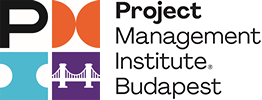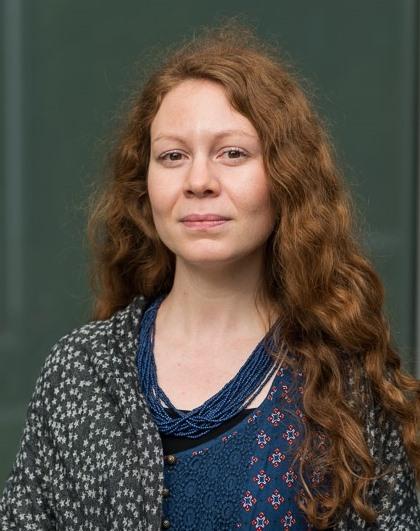June 24 2024 at 01:00PM
5 frequently asked questions during interviews for Project manager role
Building a career in Project management requires dedication to continuous learning, adapting to methodologies and frameworks, acquiring not only technical skills, but also soft skills and not lastly using emotional intelligence to face the daily challenges on projects.
In the recent PMI Job Trends report from 2024, there is mentioned an increased demand for Project management professionals in the digital transformation created by AI, construction, energy, technology and sustainability domains.
Data revealed by the PMI Economic snapshot in Q4 2023 is anticipating the need of Project managers for the 67% of the companies which responded the survey, and currently leading digital transformation projects, where 51% of the respondents are not experiencing project delays or cancellations.
So a career in Project management is even more in demand in these times marked by technological advancement but also environmental changes. In order to land that highly appreciated Project management role, the job seekers need first to navigate the recruitment process and challenges raised throughout the interviews.
During my over 10 years of career in Project management, I participated in numerous job interviews, on both sides of the interview, as an interviewee and also as an interviewer, so in this article I will reveal some of the most commonly asked questions addressed to job candidates in the Project management domain and offer suggestions on how to build a well defined, structured answer.
First I will begin by introducing the STAR approach and how this easy to remember method can help you structure the answer while providing details and driving the discussion into areas you are more experienced.
STAR method is standing for Situation, Task, Action, Result.
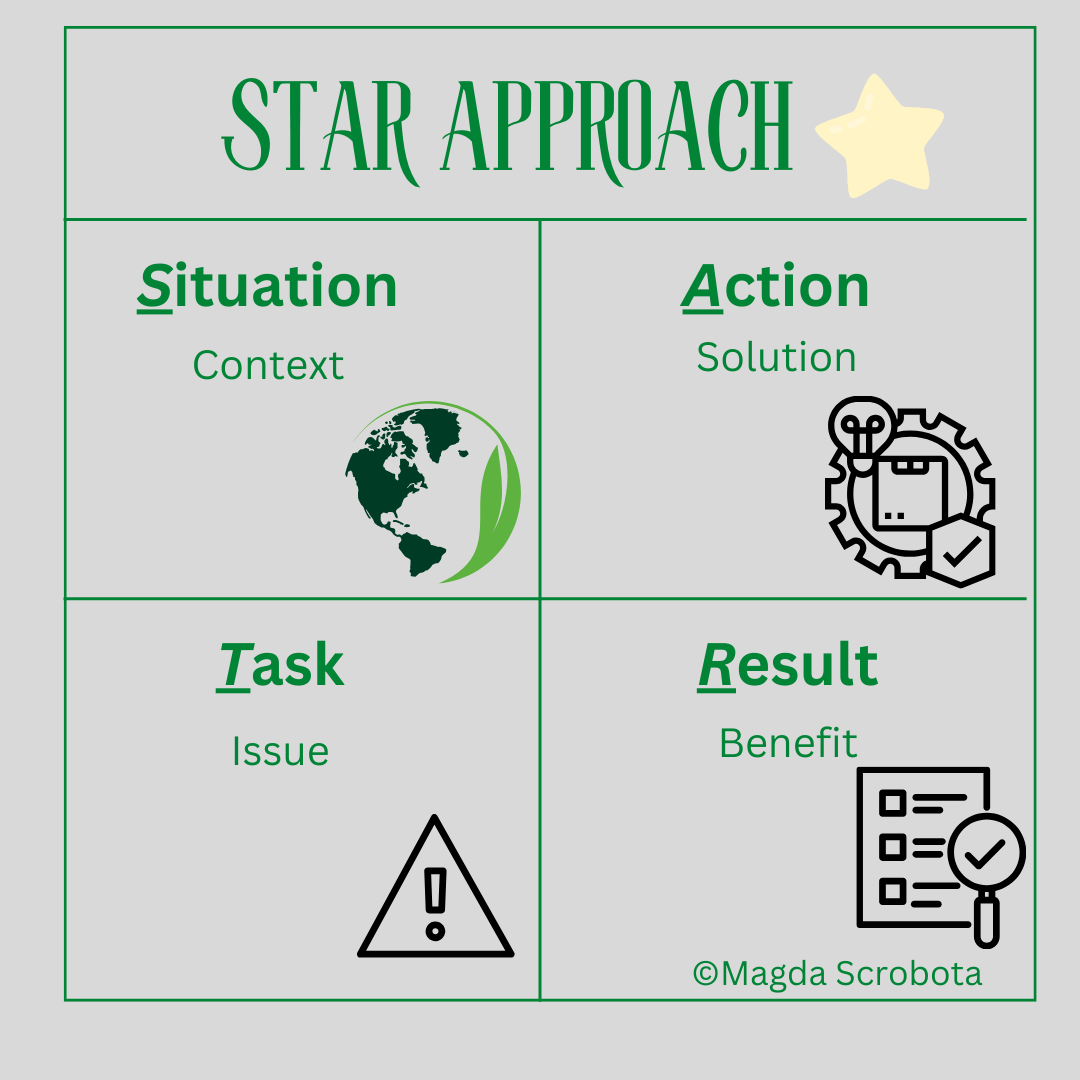
Now let’s discover what is hiding under each of these elements:
- Situation – Consider the situation as the context of the issue/question you are asked about. It is providing a wider view on the particular event, process, project or even organization where you will place your answer later on.
- Task – Think of the task in terms of what problem you were trying to solve or what the goal of your endeavour was.
- Action – This is the part where you will introduce the exact approach, solution you took to solve the issue asked by the interviewer, highlighting your skills, decision making process, design thinking approach. It is very important to focus on the capabilities you bring and how those capabilities could also be linked to the current job and company you are interviewing for.
- Result – Considering the action was successful and the goal achieved, you would want to take it one step farther and explain how your particular solution provided a long term benefit, how it improved a process used by the organization, how it contributed to the targets of more departments, etc.
During an interview, after the introductory questions about your experience in Project management and how this experience is matching the requirements for the job you are interviewing, the interviewer may have more technical questions in order to assess your knowledge, communication, problem solving and leadership skills.
I have considered 5 of the most common questions for Project managers, as shown below:
-
“Tell me about a challenge on your project and how you managed it”
For this particular question, consider a difficult situation on a project, either created by a stakeholder, or a priority related issue, a missed deadline, an issue identified before release, etc.
Whatever you decide to bring forward, thinks of this question as your opportunity to shine: your technical skills should blend in with soft skills to find the solution to your challenge while building (even) better relationship with the project stakeholders and team.
Frame the answer according to STAR approach and don’t forget to mention a few words about the impact of this challenge: on business outcomes, stakeholders, plan of the project, morale of team, etc.
Also it is important to mention the positive gains from solving the challenge on how you improved perhaps a process, a relationship with a customer or a Senior manager, a collaboration with a team, etc.
-
“What is the difference between the risk and issue?”
This is one of the favourite questions of interviewers, especially for more junior Project managers.
It would be good to know and provide the PMI definition on risk: “uncertain event or condition that, if it occurs, has a positive or a negative effect on at least one project objective, such as time, cost, scope, or quality” (PMBOK Edition 3rd p.238).
There is no trick here: risk is a hypothetical event that may impact the project in a negative or positive way. Issue on the other hand is already an event that happened and is currently impacting the project, needing a resolution, a fast reaction: “An issue is a current condition or situation that may have an impact on the project objectives” (PMBOK 7th Edition, p. 185).
To add on the risk management, it is also important to mention the risk matrix which is used to categorize the risks and their impact on project’s objectives taking into account the probability of risks to occur.
An example of risk matrix is shown below:
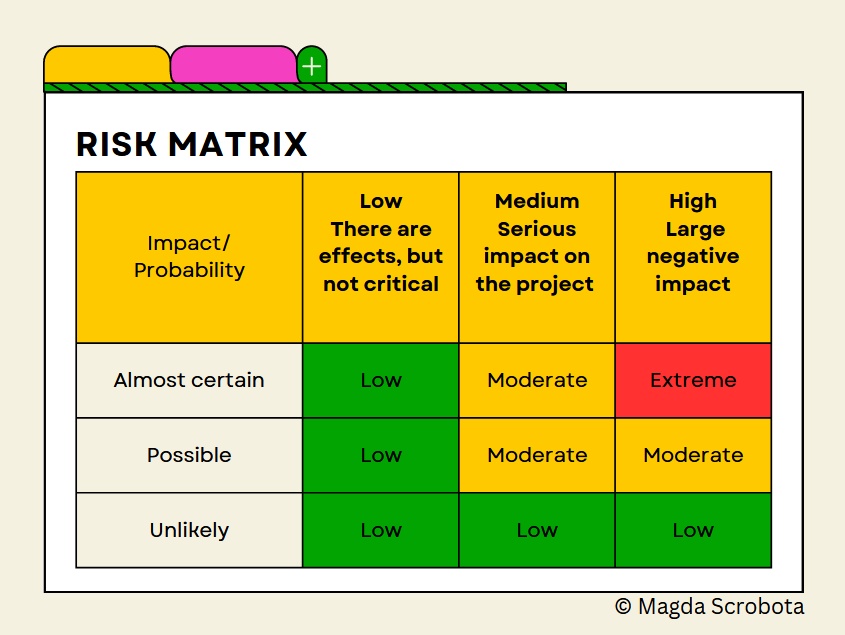
An example of risk – There could be a delay on the schedule due to a regulatory requirement not being published at expected date.
And an example of the situation when this risk becomes a real issue – The regulatory requirement was published late, so now you would need to take a quick action to address this issue.
To provide a complete answer, you could also integrate in the answer the risk response strategies depending on the category of risks and their impact, for negative risks: avoid, transfer, mitigate, accept, while for positive risks there are these strategies: exploit, share, enhance, accept.
-
“Tell me about a time when you had to deal with a difficult stakeholder and how you managed the situation”
The key word here – stakeholder – should already prompt you for the answer, as this question is meant to assess your stakeholder management skills.
Obviously the way to answer is to start by defining what a stakeholder is and how this definition links back to the stakeholder management: “stakeholders are individuals and organizations that are actively involved in the project, or whose interests may be affected as a result of project execution or project completion”(PMBOK 3rd Edition, p.24). Stakeholder management is taking into account the stakeholders’ interest and influence when deciding on what actions are needed to build a business relationship with them.
This is what is called a power/interest grid analysis for stakeholder management, as shown in the picture below:
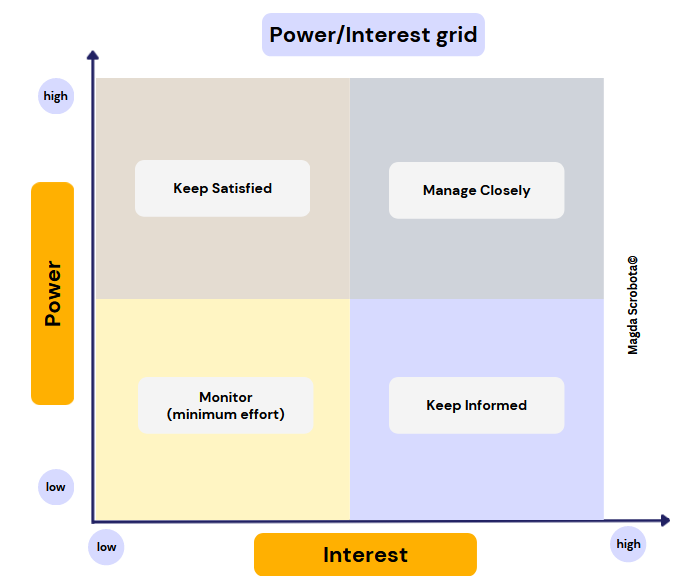
Depending on the identification and analysis of the respective stakeholder, then the Project manager should consider what kind of communication means and leadership approach are the most effective to maintain a positive relationship, while keeping the project on track.
Project manager has various methods on his/her side for an efficient stakeholder management: involve stakeholders on the decision making process, provide transparency on project objectives, timelines, risks and issues are crucial for keeping the stakeholders informed, follow-up with regular meetings outlining next steps and clear responsibilities, create visible and easy to access reports highlighting any possible challenges and deviations from the agreed schedule, budget and scope.
The answer to this question should also include the fact that dealing with stakeholders’ expectations may lead to possible conflicts on projects (topic discussed in the next section), but the overall emphasis should be on building trust, collaboration and long lasting business relationships with the stakeholders.
-
“How do you deal with conflict in your project team?”
This question is supposed to test your ability to manage conflict, team dynamics and understanding of business interests on the project objectives and possible valuable outcomes.
It is important to mention that conflict, while being seen as a negative situation on the project, it may also have positive consequences such as better communication between various teams or departments in the organization, improved processes, stronger collaboration and higher level of trust between project team and management. Conflict is inevitable especially when working with cross-functional teams from different technical and cultural backgrounds, so the conflict resolution lies on the Project manager’s skills to manage the situation, keeping the right balance between morale of the team and the project objectives.
Structuring the answer around the STAR approach, will provide the right balance between presenting the context and cause of conflict, but also give insights in the leadership skills of the Project manager so it would be worth to spend some minutes on this aspect too.
Regarding the technical part of the answer, the conflict management model designed by Kenneth W. Thomas and Ralph H. Kilmann is based on 2 dimensions (assertiveness and cooperativeness), offering 5 resolutions to conflict in work places.
Assertiveness, although possibly seen as negative trait, on the spectrum of authoritarian behaviour, is actually a skill for being self-assured and pushing a right point of view, without being aggressive.
Cooperativeness, on the other hand, is a trait of how much a person is agreeable in the relations with others, without pushing their own view, but inviting to collaboration.
- Avoiding – this is the passive approach in which no action is taken, and the expectation is to wait for the conflict to dissolve by itself. In reality, especially in work places, this approach will not function, the initial cause of the conflict would only get more attention and lead to more impactful consequences. If the conflict would be happening in a structure with less impact on the project, then this approach could be convenient, but in majority of cases, the conflict cannot be ignored.
- Accommodating – for this approach, the conflict is solved by prioritizing the expectations of one side of the conflict, agreeing to the demands of this party. This kind of resolution is fast but not necessarily considering multiple perspectives of conflict and possible outcomes of the project. If the resolution seems unfair to the other side of the conflict, then the underlying cause of the conflict would still persist and negatively influence the project.
- Competing – being in a position of authority, one party of the conflict would try to enforce their own view on the conflict resolution, while ignoring the other party. This conflict resolution could be easily summarized as “my way or the highway”. It may provide quick solutions, but on long term if the solution proves wrong, the party who would enforce it, may suffer reputation damage and distrust from other colleagues in the organization.
- Compromising – having similarities with the competing resolution, where not all parties of the conflict would find a satisfactory outcome, this approach is more fit for parties with equal authority on the project, being able to find a middle way between their interests and the overall project objective (PMBOK Edition 7th, p.168)
- Collaborating – this is a preferred approach when the overall communication and collaboration in the team is highly desired and when there is not a stringent time pressure to reach a resolution. In this way, all parties are involved in the conflict resolution, their alternatives being analysed and a feasible solution in line with their expectations is adopted.
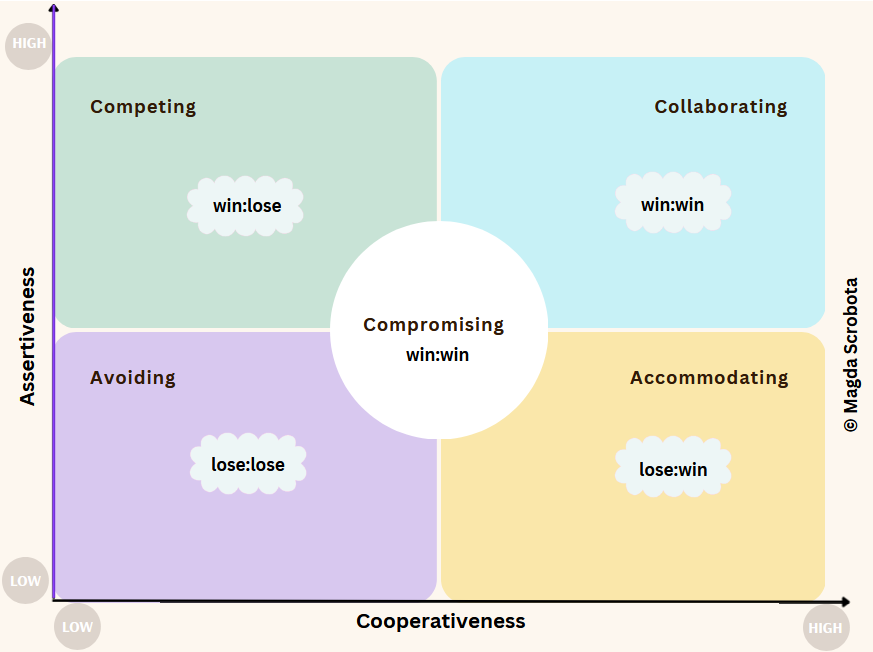
-
“Tell me about a time when a team member was underperforming and how you managed the situation”
The question regarding the underperforming team member is reaching for the leadership and people management skills of the interviewee.
This question should be approached from the perspective of the leader who is always creating a positive, collaborative environment where every team member is trusted and can express concerns or issues freely, but also from the management perspective who is interested in the progress of the project, keeping work on track and realizing the planned benefits.
To answer the question, I would recommend to refer to the situational leadership model, initially developed by Hersey and Blanchard (1969), where a true leader can juggle the support level offered to the team, from directive to supportive behaviour to handle a particular situation.
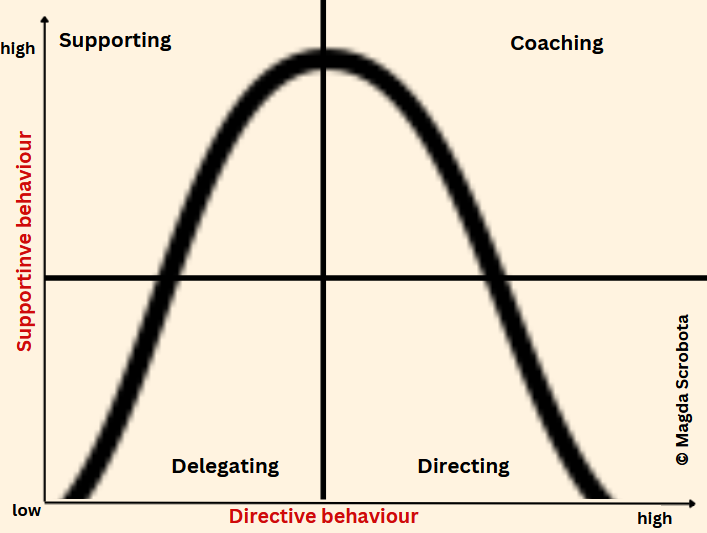
For this particular case of the team member underperforming, the answer should concentrate on what kind of supportive behaviour the Project manager displayed: understanding the root cause of the situation – personal issues conflicting with the ability to perform duties, misunderstanding of the assignment, lack of skills or resources, systemic issue, etc.
If the Project manager previously created an open, collaborative environment, the communication with the team member should be based on trust and empathy to really understand the underlying cause of the underperformance and together with the team member, the Project manager could find a mutually beneficial solution: a better transparency and explanation of tasks and responsibilities, a course or training to upskill the team member, a pair approach or shadowing period with a more senior team member, a split of tasks into smaller chunks so the team member can complete them on time, etc.
Considering this question is testing the leadership style and knowledge of the interviewee, the answer should bring forward which leadership behaviour (for this kind of question, the supporting and coaching, followed by delegating when the team member would overcome the performance issues) would be most beneficial in order to keep maintaining a positive collaborative relationship, provide an example for the other team members as well, but also to aim for the project progress towards objectives.
Having presented these techniques and models on how to approach such questions, I hope you will be better equipped to face the challenges of any interview for the Project management professionals roles.
In addition to these, remember that spending some couple of seconds to formulate the answer, asking the interviewer additional questions to better understand the concepts or context are perfectly acceptable. When in stressful situations, a confident, positive attitude will always bring better results and set you apart from other candidates.
Good luck!
Author
References
- PMI Global Project Management Job Trends report 2024
- PMI A Guide to the Project Management Body of Knowledge PMBOK 3rd Edition 2004
- PMI A Guide to the Project Management Body of Knowledge PMBOK 7th Edition 2021
